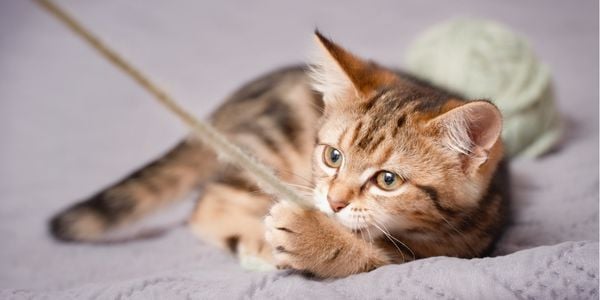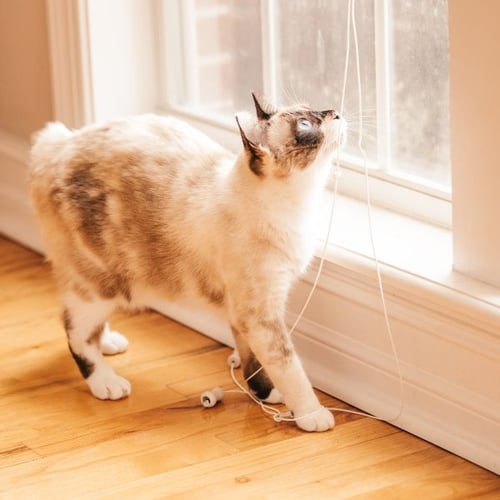 Throughout the day, we ponder many things. Maybe I am wrong, but generally, we would rather not have to ponder whether or not we should pull or not pull a string hanging out of our cat’s butt.
Throughout the day, we ponder many things. Maybe I am wrong, but generally, we would rather not have to ponder whether or not we should pull or not pull a string hanging out of our cat’s butt.
But if you have a cat, this question will likely need to be answered at least once, if not more.
While cats don’t commonly ingest things they shouldn’t, unlike dogs, they often have the desire to ingest "string-type" items.
Cats are hunters, and stringy things have similarities to prey in the way they twist and turn — the way prey responds when captured by a cat. What does a cat do when they are done playing with their prey? They eat it. Hence, one reason they like to eat long, thin, stringy items.
Skip to section:
'To Pull or Not to Pull a String ?' – That is the Question!
What about the times you don’t see your cat eating a string, and the only evidence is protruding from your cat’s butt? This is where you ponder, "to pull or not to pull?"
While that is the question, Hamlet likely doesn’t know the answer, but it is important that you do! Unfortunately, with many questions that relate to cats, there really isn’t a clear-cut answer. Every situation is a bit different.
We're happy it seems to have worked out for this family, but unfortunately it doesn't always work out that well for many cats.
When to Gently Pull on the String?
In most cases (and only if your cat seems perfectly normal), you can initially attempt a very gentle and slow tug of the string while someone else holds your cat to ensure the cat doesn’t run off. If the string comes out easily, great.
If your cat will safely allow you, check to see if there is string wrapped around the base of their tongue, which may only be noticeable to you as a purple, swollen tongue.
Do not pull string attached to the inside of your cat's mouth – head straight to a vet or an ER. String that is working its way through the intestinal tract and is caught around the tongue will start to pull and cut off circulation to the tongue.
Even though you removed the string from the anus, you should get your cat to the vet immediately, as some could still be left inside, causing harm by getting entangled in their intestines.
A veterinarian will take an x-ray to look for the "classic" sign of a linear foreign body – this could show that the intestines are all bunched up. If the x-ray results are questionable and you want confirmation before agreeing to surgery, an ultrasound may be used to detect the effects of the string internally.
When to Stop and Not Pull?
This is very important — if there is any resistance when trying to remove the string, you must stop pulling immediately and bring your cat to the vet for evaluation.
Why you may ask?
Because the resistance may well indicate that the portion of the string still inside your cat’s intestines is wrapped around something or embedded within the lining of their intestines, and by continuing to pull, you may cause a tear in their intestines or rectum that could result in pain, infection, or leakage of intestinal contents into their abdominal cavity.
None of which you, or your cat, want.
Safely Cut the String From Your Cat's Bum
If you can do so safely (i.e., without cutting their tail or their rectum), you can use scissors to cut the protruding portion of the string prior to transport to the vet. This can help to decrease the chances that it will get tangled around something and cause problems of its own.
Leave an inch or two hanging out, and be sure to bring the cut portion with you to the vet so that they can see what type of material they are dealing with and gauge the approximate length.
True Story: One of the clients at my clinic was a very observant cat mom. She was sewing and realized that her cat took and ingested the needle and thread she was using. She brought the cat immediately to my hospital.
Fortunately, an x-ray revealed that the needle was still in the stomach. (It would have been extra bad if it had made its way into the intestines!)
The cat was taken to surgery, and it successfully removed both the needle and thread. The cat did great!
But what if my client didn’t realize what her cat did? Things could have gotten so much worse!
It was possible that when she went to feed her cat later that day, and as the stomach contracted to push the digested food into the intestines that the needle would have pushed through the stomach wall and possibly damaged other intestines and/or organs. It could have resulted in a linear foreign body.
And lastly, it was possible that just the string may have protruded out of her cat's butt with the needle caught in the lining of the intestines. If she happened to pull it too hard or quickly, this could have resulted in significant trauma to the intestines.
Should I Leave the String in and See If It Comes Out On its Own?
It’s a good question. And, of course, it’s not a very straightforward situation. It’s tricky because SO much of it depends on how your cat is doing in general and how close an eye you can keep on them (and their poos).
It truly is always best to err on the side of caution and have your cat evaluated by your vet — once there, if the cat is otherwise doing well and/or you can’t afford diagnostics (x-rays, etc.) and/or surgery, then at least your vet has seen and evaluated your cat and can talk to you about options and, if elected, give you home care recommendations and advise you on things to watch for.
If you do decide to “wait and see,” safely cut the protruding string (as described above), and monitor your cat’s appetite, energy, comfort level, and litter box trips VERY closely.
If your cat exhibits a drop in appetite, vomiting, decrease in energy level, signs of pain, straining and/or vocalizing within the litter box, or any other concerning signs, they truly must be brought to the vet immediately.
Questions? To chat with a veterinarian about your cat and string, Click here
String-like Things Cats Like to Swallow
Until you have a cat, you don’t realize how many "stringy things" you have in your home. I suggest taking extra precautions with anything string-like greater than 5 to 6 inches in length for adult cats and nothing over 2 inches for kittens.
Some string items that your cat may ingest include:
- Yarn
- Sewing thread – both with or without a needle
- String
- Cords or ties on toys
- Ribbons hanging from helium balloons
- Doggie rope bones (the threads can sometimes break off or easily be pulled out)
- Shoelaces
- Ribbon
- Dental floss
- Fishing line
- Rubber bands
- Hair ties
- Necklaces and strings of beads
- Streamers
- Carpet fringe
- Wire
- Twist ties
- Pipe cleaners
- Thin cords
- Fake cobwebs
- Easter grass
- Tinsel
- Trussing from the holiday turkey
- Any other thing they think is stringy!
Just A Note: In addition to stringy items, cats also like to ingest linear items like Q-Tips®. I know this from the very personal experience of having to pull one from my cat’s butt.
The side protruding out of my cat appeared perfectly normal, while the other resembled a Tootsie Roll pop.
Please keep this in mind and don’t leave Q-Tips, cotton swabs, or other similar items laying around where your cat may find them – that includes in the waste bin.
There are some cats, I know because mine did, who eat strands of hair or blades of grass. Typically, since hair is thin and fragile and grass is short in length, they cause no harm.
The only issue that generally occurs is that you may have to assist in removing a poop ball hanging from a piece of hair or gently remove a piece of grass that is stuck to their anus.
When to Call Your Veterinarian?
Despite being diligent and trying to cat-proof your home, sometimes our furry felines are more observant, faster, and sneakier than we are, and they get their stringy prize.
Knowing what and when they ingested a string-type item is always helpful. In these situations, promptly call your veterinarian for advice.
Depending on what it is and how your cat is doing, they may advise you to bring your cat in immediately or have you closely monitor them at home (sometimes up to a couple of weeks) for any symptoms or abnormal behavior. See the steps above if you choose to take matters into your own hands.
It truly is always best to err on the side of caution and have your cat evaluated by your vet.
Once there, if your cat is otherwise doing well and/or you can’t afford diagnostics (x-rays, etc.) and/or surgery, then at least your vet has seen and evaluated your cat and can talk to you about options. They can then give you home care recommendations and advise you on things to watch for.
If you notice any of these symptoms or abnormal behavior, contact a veterinarian immediately.
Questions? If your cat swallowed string and you want to chat with a veterinarian, Click here
Some things to closely monitor your cat for include:
- Decreased appetite
- Lethargy (inactivity)
- Vomiting
- Diarrhea
- Straining to poop
- Abdominal pain
- Change in behavior, such as hiding or avoiding contact
- Restlessness or the inability to get comfortable
NOTE: If you're taking the "wait and see" approach, be sure to check your cat's anus and poop each time they go to see if the stringy item has passed.
 Prevention Is Key!
Prevention Is Key!
Do your very best, now that you know some of the stringy prey items that cats may like, to keep them out of reach of your cat.
But be sure to leave cat-safe toys for them to play with, especially while unsupervised, as this will go a long way to ensure your cat doesn't ingest something they shouldn't and cause your cat a lot of discomfort and potentially life-threatening harm.
Tips for prevention:
- Keep all craft items, ribbons, piper cleaners, etc., in a secure location. While crafting, keep your cat in a safe and secure location so they can’t take items.
- At the holidays, avoid tinsel and ribbons. Wrap gifts in a room away from your cat and put them in a secure place where your cat can’t reach them.
- Keep yarn, thread, and string items secure and out of reach when not using.
- Be sure to only place stringy items (i.e., dental floss) in a waste basket that has a secure lid.
- Avoid toys with ribbons and strings. This includes any dog toys as well.
- Check bedding and blankets for loose or hanging thread.
- If playing with a piece of string that isn't attached to a larger object, like a wand, hide the string after playtime has ended. And when you are playing, tie the string to your finger. It's best to put away all toys with strings when your cat is not being supervised.
- Tie up blind cords as they pose additional strangulation dangers in addition to the danger of chewing and eating the strings.
- Be sure that your cat has enrichment that meets their instinctual need to hunt. For cat-safe toys, check out what our cat behavior expert recommends for simulating hunting.
Also, if you're so inclined, here are a few DIY cat toys you can make that are safe and your cat might really enjoy.
Have fun and play safe!




